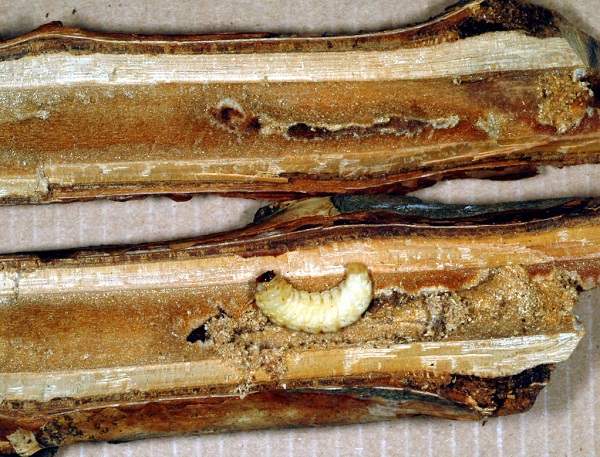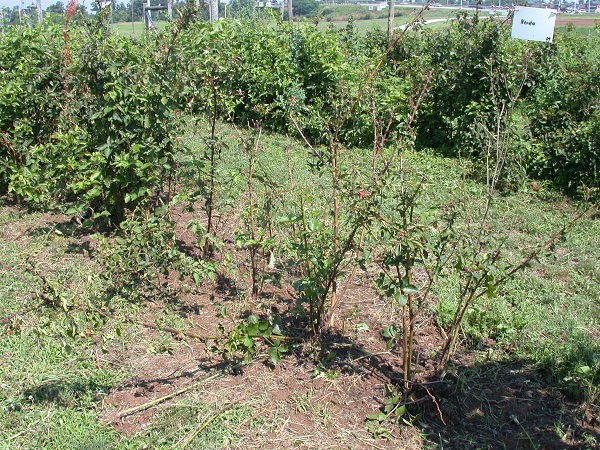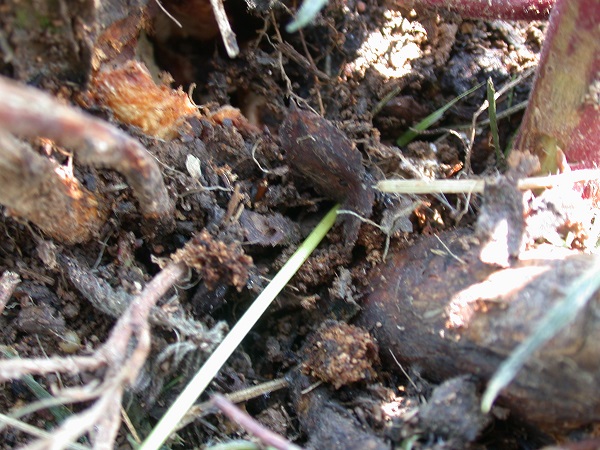Rasberry Crown Borer
ENTFACT-226: Rasberry Crown Borer | Download PDF
by Ric Bessin, Extension Specialist
University of Kentucky College of Agriculture
Raspberry crown borer is the most devastating pest of blackberry and raspberry in Kentucky. While not as obvious as Japanese beetle or green June beetle attacking the fruit, raspberry crown borer attacks the roots and crown of the plants and can result in killed or weakened canes. Raspberry crown borer symptoms include canes prematurely dying, spindly cane growth, and reduced leaf size. If you suspect raspberry crown borer, look for sawdust-like frass pushed out of the base of infested canes near the soil, swelling at the base of the canes, or tunnels in the canes that are noticed while pruning. This is a common pest of blackberries and raspberries throughout the state that can severely reduce the productivity of a planting.
Identification
The raspberry crown borer adult is a clearwing moth that resembles a medium-sized yellowjacket in coloration and size. However, yellowjacket wasps have few hairs and no scales, while the adult raspberry crown borer has noticeable scales on the body and wings. This is a day flying moth that is active in late summer and early fall. The cream-colored larva is the stage that causes the damage and is very similar in appearance to other clearwing borer larvae (such as squash vine borer, dogwood borer, peachtree borer, and grape root borer).

Figure 1. Raspberry crown borer and tunneling damage.
Life Cycle
Studies have shown that the life cycle takes one year in Arkansas and two years in Ohio. In Kentucky, it is thought that the larvae require two years to complete their development. Moths emerge from July through September and lay their eggs singly on the undersides of the leaves. The eggs hatch in one to two months and the larvae crawl down the cane to tunnel under the soil line. They form a blister-like overwintering site on the side to the cane. The following spring they begin tunneling in the cane. The second winter is passed as a larva while in the roots. They pupate within the canes during the second summer.

Figure 2. Waste material from raspberry crown borer pushed out of stems.
Cultural Control
Management of the raspberry crown borer begins with the removal of wild brambles near the planting. This also aids in the management of other insect and disease problems with brambles. During pruning and cane removal activities, look for 1/4 inch tunnels in the base of canes, this is sure sign of cane borer activity. Within the planting, infested canes and crowns should be identified, removed, and destroyed.
Biological Control
Some trials of soil drenches using insect-pathogenic nematodes, such as Heterohabditis bacteriophoba or Hb nematodes, as biological control agents have been successful against crown borers. These nematodes infect and kill only insects, not plants or other organisms.

Figure 3. Raspberry crown borer injury to blackberry plants.
Chemical Control
Currently, the only insecticides registered for raspberry crown borer control in Kentucky are Restricted Use Pesticides for use in commercial plantings. They are applied in September or October, or at bud swell in the spring, as a drench to the lower cane and soil around the base of the plants. Applications in the fall may be more effective than in the spring. This application prevents new infestations and will not control second-year larvae. For this reason, applications for several seasons may be needed to achieve control.
Revised: 11/19
CAUTION! Pesticide recommendations in this publication are registered for use in Kentucky, USA ONLY! The use of some products may not be legal in your state or country. Please check with your local county agent or regulatory official before using any pesticide mentioned in this publication.
Of course, ALWAYS READ AND FOLLOW LABEL DIRECTIONS FOR SAFE USE OF ANY PESTICIDE!
Photos courtesy Ric Bessin, University of Kentucky Entomology
